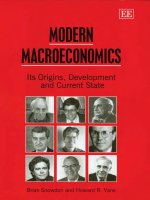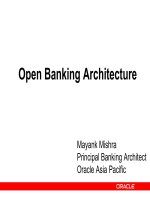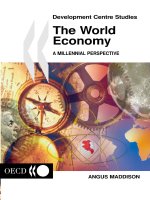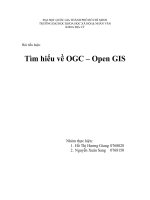open economy macroeconomics
Bạn đang xem bản rút gọn của tài liệu. Xem và tải ngay bản đầy đủ của tài liệu tại đây (180.88 KB, 20 trang )
Chapter 29
Open economy macroeconomics
David Begg, Stanley Fischer and Rudiger Dornbusch, Economics,
6th Edition, McGraw-Hill, 2000
Power Point presentation by Peter Smith
29.1
Open economy macroeconomics
… is the study of economies in which
international transactions play a
significant role
– international considerations are especially
important for open economies like the UK,
Germany or the Netherlands
Domestic macroeconomic policy in such
countries cannot ignore the influence of
the rest of the world
– especially via the exchange rate.
29.2
The foreign exchange market
- the international market in which one national currency can
be exchanged for another.
The price at which two currencies exchange is the
exchange rate.
DD
DD shows the demand for
pounds by Americans wanting
to buy British goods/assets.
Quantity
of pounds
Exchange rate ($/£)
Suppose 2 countries: UK & USA
SS
SS shows the supply of pounds
by UK residents wishing to buy
American goods/assets.
e
0
Equilibrium exchange rate is e
0
SS
1
If UK residents want more $
at each exchange rate, the
supply of £ moves to SS
1
e
1
New equilibrium at e
1
.
29.3
Alternative exchange rate regimes
In a fixed exchange rate regime
– the national governments agree to
maintain the convertibility of their
currency at a fixed exchange rate.
In a flexible exchange rate regime
– the exchange rate is allowed to attain its
free market equilibrium level without
any government intervention using
exchange reserves.
29.4
Intervention in the forex market
Quantity of £s
SS
DD
e
1
Suppose the government is
committed to maintaining the
exchange rate at e
1
When demand is DD, no intervention is needed
there is a balance in transactions between the countries.
The Bank of England must
supply AC £s in return for $,
which are added to reserves.
DD
1
If the demand for pounds is DD
1
there is excess demand AC.
A C
DD
2
The reverse occurs if
demand is at DD
2
.
E
29.5
The balance of payments
… a systematic record of all transactions
between residents of one country and the
rest of the world
Current account
– records international flows of goods, services,
income and transfer payments
Capital account
– records transactions involving fixed assets
Financial account
– records transactions in financial assets
29.6
The UK balance of payments, 1980-1998
-25
-20
-15
-10
-5
0
5
10
15
20
25
£ billion at current prices
1980
1982
1984
1986
1988
1990
1992
1994
1996
1998
Current
Capital
Financial
Err & om
Source: Economic Trends Annual Supplement
29.7
Floating exchange rates
and the balance of payments
If the exchange rate is free to move
to its equilibrium, there is no need
for intervention
any current account imbalance is
exactly matched by an offsetting
balance in capital/financial accounts
if there is intervention, it is recorded
as part of the financial account.
29.8
International competitiveness
The competitiveness of UK goods in
international markets depends upon:
– the nominal exchange rate
– relative inflation rates
Overall competitiveness is measured
by the real exchange rate
– which measures the relative price of
goods from different countries when
measured in a common currency
29.9
Relative prices and the nominal
exchange rate, UK & USA
0.5
1
1.5
2
2.5
3
1971
1973
1975
1977
1979
1981
1983
1985
1987
1989
1991
1993
1995
1997
$/£
0.4
0.5
0.6
0.7
0.8
0.9
1
1.1
Relative price (UK/USA)
Relative price
(UK/USA)
Exchange rate ($/£)
29.10
The real £/$ exchange rate
0
0.5
1
1.5
2
2.5
1971 1974 1977 1980 1983 1986 1989 1992 1995 1998
£/$
The real exchange rate is the nominal rate multiplied
by the ratio of domestic to foreign prices
29.11
Components of the balance of payments
The current account is influenced by:
– competitiveness
– domestic and foreign income
The capital & financial accounts are
influenced by:
– relative interest rates
which affect international capital flows.
Perfect capital mobility
– occurs when there are no barriers to capital
flows, and investors equate expected total
returns on assets in different countries
29.12
Internal and external balance
Internal balance
– a situation for a country when aggregate
demand is at the full-employment level
External balance
– a situation for a country when the current
account of the balance of payments just
balances
The combination of internal and external
balance is the long-run equilibrium for the
economy.
29.13
Shocks may move an economy away
from internal and external balance:
Boom
Slump
Surplus
Deficit
More saving,
tighter fiscal &
monetary policy
Foreign boom,
lower real
exchange rate
Foreign slump,
higher real
exchange rate
Less saving,
easier fiscal &
monetary policy
29.14
Macroeconomic policy under fixed
exchange rates
Under fixed exchange rates, there is a crucial link
between external imbalance and domestic money
supply.
When the government intervene to maintain the
exchange rate, there is a direct effect on money
supply.
Sterilization
– an open market operation between domestic money and
domestic bonds to neutralize the tendency of balance of
payments surpluses and deficits to change domestic
money supply.
29.15
Monetary policy under fixed exchange rates
Assume: perfect capital mobility, sluggish prices
An increase in nominal money supply
– tends to reduce interest rates
– leads to a capital outflow
– reducing money supply as the government
seeks to maintain the exchange rate
so monetary policy is powerless
– the government cannot fix independent targets
for both money supply and the exchange rate
– domestic and foreign interest rates cannot
diverge
29.16
Fiscal policy under fixed exchange rates
Assume: perfect capital mobility, sluggish prices
An increase in government expenditure;
in the short run
– stimulates output
– but also increases interest rates
– which leads to a capital inflow
– money supply expands to maintain the exchange rate
– there is no crowding-out
– as interest rates cannot rise
in the long run:
– wages and prices adjust, affecting competitiveness
– the economy returns to potential output.
29.17
Monetary policy
under floating exchange rates
Time
e
e
1
Suppose the economy begins in equilibrium
with the nominal exchange rate at e
1
.
t
A
At time t, nominal money
supply is halved
e
2
e
2
will be the new equilibrium
exchange rate once the
economy has adjusted
But prices are sluggish, so
in the short run, real money
supply falls and domestic
interest rates rise
e
3
B
To maintain equilibrium in the forex market, the exchange
rate overshoots to e
3
C
, adjusting along BC with wages & prices.
29.18
Monetary policy
under floating exchange rates (2)
This analysis suggests that with
floating exchange rates,
monetary policy is highly effective in
the short run
but the effect is only transitional
29.19
Fiscal policy
under floating exchange rates
Following an increase in government
expenditure
the crowding-out effect of higher
interest rates is enhanced by
appreciation of the exchange rate
– which dampens export demand
so fiscal policy is less effective
under floating exchange rates.









